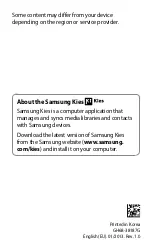
Appendix
FCC RF EXPOSURE INFORMATION
Warning! Read this information before using your phone.
Warning! Read this information before using your phone. In August
1996, the Federal Communications Commission (FCC) of the United
States, with its action in Report and Order FCC 96-326, adopted an
updated safety standard for human to radio frequency
electromagnetic energy emitted by FCC regulated transmitters. Those
guidelines are consistent with the safety standard previously set by
both U.S. and international standards bodies. The design of this
phone complies with the FCC guidelines and these international
standards.
Body-worn Operation
This device was tested for typical body-worn operations with the back
of the phone kept 0.39 inches (1.0 cm) from the body. To comply with
FCC RF exposure requirements, a minimum separation distance of
0.39 inches (1.0 cm) must be maintained between the user's body
and the back of the phone, including the antenna. All beltclips,
holsters and similar accessories used by this device must not contain
any metallic components. Body-worn accessories that do not meet
these requirements may not comply with FCC RF exposure limits and
should be avoided. This device is not intended to be used with a
lanyard or strap on the body. The device contains a mounting point
that may be used to attach the device to equipment, a backpack or
tool belt, etc.
Turn off your phone before flying
You should turn off your phone when boarding any aircraft. To prevent
possible interference with aircraft systems, U.S. Federal Aviation
Administration (FAA) regulations require you to have permission from
a crew member to use your phone while the plane is on the ground. To
prevent any risk of interference, FCC regulations prohibit using your
phone while the plane is in the air.
European RF Exposure Information
Your mobile device is both a radio transmitter and receiver, and is
designed not to exceed limits for exposure to radio waves
recommended by international guidelines. These guidelines were
produced by independent scientific organization, ICNIRP, and include
safety margins designed to protect all persons, regardless of age and
condition of health.
The guidelines apply a unit of measurement known as the Specific
Absorption Rate (SAR). The SAR limit for mobile devices is 2 W/kg,
and the highest SAR value for this device was 0.756 W/kg*.
As testing measures SAR at the highest transmitting power of a
device, actual SAR tends to be lower during ordinary operation. Lower
SAR levels are typical during ordinary operation as automatic changes
are made within the device to ensure the network can be reached with
minimal power.
The World Health Organization (WHO) has stated that present
scientific information does not indicate the need for any special
precautions to be adopted when using mobile devices. WHO also
notes that those wishing to reduce exposure may do so by limiting call
length and by using a
‘
hands-free’ device to distance the phone from
the head and body. For further information, please see the WHO
website:
(
http://www.who.int/peh-emf/en/
)
* Note that tests are also carried out in accordance with international
testing guidelines.
96







































